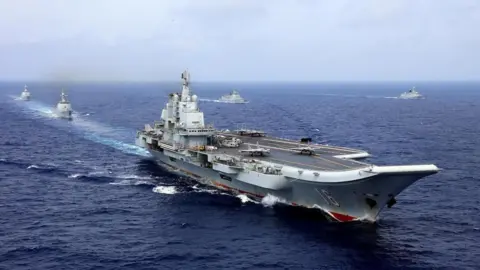The recent naval drills carried out by China near Japan have ignited significant concern and led to heightened diplomatic tensions between the two countries. Japan’s government has lodged a formal protest with Beijing, making a rare public disclosure regarding the movements of the Chinese military. This comes at a time when tensions in the region are palpable, as both nations navigate their complex relationship against a backdrop of shifting geopolitical dynamics.
In a striking development, China’s two aircraft carriers, the Shandong and the Liaoning, have been simultaneously conducting military exercises in the Pacific, marking an unprecedented military maneuver. Reports indicate that Chinese fighter jets have performed hundreds of take-offs and landings from these carriers, with some closely approaching Japanese reconnaissance aircraft. This provocative activity has prompted Japan to express its “serious concerns” to China regarding the safety risks associated with such maneuvers.
In defense of its actions, China has asserted that its naval activities adhere to international law, while accusing Japan of engaging in “dangerous moves.” The tone of the exchanges reflects a broader narrative where each side holds to its position, with Japan emphasizing the dangers posed by the proximity of Chinese military operations to its airspace and maritime zones.
Japan’s defense ministry has taken the step of releasing a detailed map that tracks the daily positions of the Chinese aircraft carriers since May 25. This is unusual for Japan, which typically refrains from publicly sharing such sensitive military information. The map clearly indicates both carriers sailing near Japanese islands and transiting through Japan’s exclusive economic zone (EEZ). The EEZ is a maritime area beyond the territorial waters, where a nation has special rights regarding exploration and exploitation of marine resources, yet freedom of navigation is guaranteed for other states.
Additionally, Japanese authorities reported the Liaoning’s proximity to the “second island chain,” a significant defense line in US strategic doctrine that stretches from Japan to Guam. This action represents a notable development, as highlighting the Liaoning’s passage in these sensitive waters signifies a tactical expansion of Chinese capabilities.
Documentation from Japan suggests that there have been over 500 take-offs and landings of Chinese aircraft, further complicating the regional security landscape. Notably, there were incidents where Chinese fighter jets shadowed Japanese surveillance aircraft for extended durations, with Japanese officials expressing alarm over these “abnormal approaches” that elevated the risk of potential collisions.
In response to Japan’s concerns, Chinese foreign ministry spokesman Lin Jian has contended that their military operations are within the bounds of international practices and that Japan’s reconnaissance activities near Chinese vessels are the provocations leading to security risks in maritime and aerial spaces. This back-and-forth reflects a struggle for narrative control as both nations seek to justify their military posturing.
As part of these military activities, China is also advancing its naval capabilities with the upcoming entry of the Fujian aircraft carrier into service later this year. This carrier will feature state-of-the-art electromagnetic catapult technology, a system currently exclusive to American vessels, potentially allowing China to broaden its operational scope in military aviation.
This situation unfolds against a backdrop of global reactions, as seen previously when China undertook naval exercises in the Tasman Sea that drew ire from Australia and New Zealand due to a lack of advanced notification. As the United States maintains its commitment to a strong military presence in the Indo-Pacific region, it balances its resources amid escalating tensions elsewhere, such as conflicts involving Israel and Iran.
Professor Kazuto Suzuki from the University of Tokyo suggests that the timing of China’s naval exercises represents an attempt to gauge US-Japan military unity at a juncture when American focus may be diverted towards the Middle East. He characterizes this strategy not as an outright escalation, but rather a gradual probing of any weaknesses in Japan’s maritime defenses.
In conclusion, the Chinese navy’s recent drills near Japan have reignited longstanding issues of territorial and military sovereignty in East Asia. As Japan and China navigate this sensitive period, the potential for miscommunication and conflict remains heightened, particularly in international waters where both nations exercise their maritime rights. This evolving situation highlights the delicate balance of power in the region, revealing the complexities of geopolitical relationships and the often thin line between military training and provocation.



